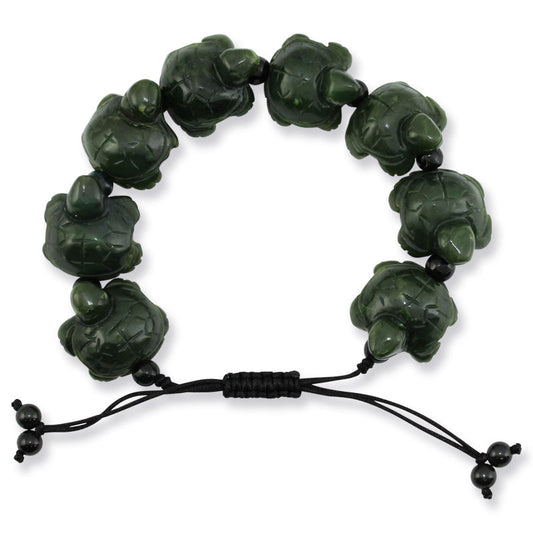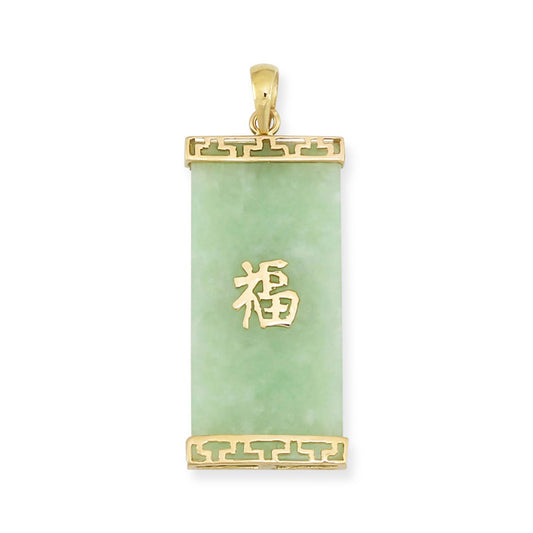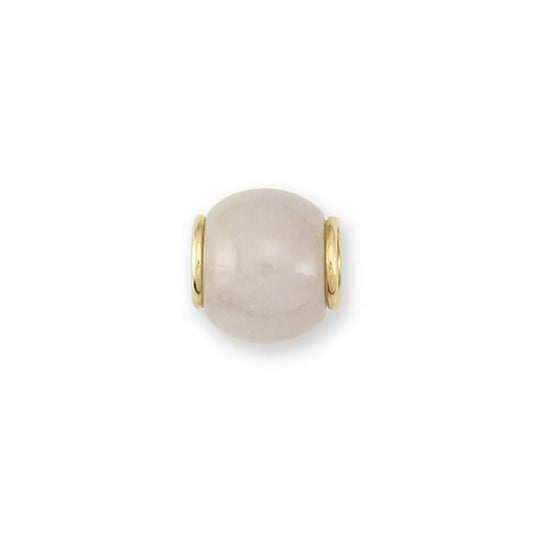Are you shopping for jadeite jade jewelry, but not sure where to start? Don't let this scare you, but jade is one of the most mimicked gems on the planet -- and unfortunately, many sellers do not disclose treatment of genuine jadeite jade because it can be very difficult to detect.
At Mason-Kay Jade, we do in-house testing to guarantee that all of our jadeite jade is natural, meaning untreated.
You can buy natural jade that's free of treatment, and you can pay an appropriate price for it! You just need to know how to watch out for jade seller 🚩 red flags:
#1. "Jade" doesn't always mean Jade
🚩If the item is called "Jasper Jade" or "Agate Jade," then it's not Jadeite Jade or Nephrite Jade.
It's important to remember that, in the US, there are two gemstones gemologically considered to be "jade:" Jadeite jade (also called fei cui) and nephrite jade. Jasper, quartz, serpentine, and grossular garnet are not jadeite jade or nephrite jade.
Jade is a trade term, and some online overseas sellers will use the word "jade" interchangeably with "beautiful stone" -- meaning they'll call a gemstone jade even if it's not jadeite jade or nephrite jade.
More sneakily, some terms such as Transvaal Jade (grossular garnet) or "Queensland Jade" sound like they're referring to Jadeite Jade or Nephrite Jade, but they do not.
Sellers should always clarify whether the stone they're selling is jadeite jade or nephrite jade, or something else entirely.
Here is a quick chart of gem names that might confuse the jade shopper:
| Trade Name | Actual Gemstone | Caveat |
| Jasper Jade | Jasper | |
| Agate Jade | Agate | |
| Korean Jade | Serpentine | Nephrite jade does come from South Korea, so a seller will probably clarify this when selling. They'll probably call it "Korean Nephrite Jade" if it's actual jade. |
| Australian Jade / Queensland Jade | Chrysoprase | Nephrite jade does come from Australia, so a seller will probably clarify this when selling. They'll probably call it "Australian Nephrite Jade" or "Cowell Jade" if it's actual jade. |
| Transvaal Jade | Grossular Garnet | |
| Red Jade / Pink Jade | Grossular Garnet | Both jades can be red, so some red jade actually is jadeite jade or nephrite jade. Additionally, some lavender jade looks pink-ish. Jadeite jade can have pink grossular inclusions, and nephrite jade can have pink thulite inclusions. Ask the seller for clarification if they're selling "pink jade," as most pink jade is not legit. |
| Fei Cui | Jadeite Jade, Omphacite Jade or Kosmochlor Jade |
The term "fei cui" is interchangeable with "jadeite jade," "omphacite jade," and "kosmochlor jade." |
| Tremolite | Tremolite or Nephrite Jade | Microcrystalline tremolite is nephrite jade, so don't be alarmed if a seller says their nephrite jade is "tremolite." |
| Kortes Black Jade | Appropriately called Kortes Black Jade, this is a hornblende-like mineral in the amphibole family | Kortes Black Jade is a material chemically and structurally very similar to nephrite jade. |
| Turkish Purple Jade | Microcrystalline quartz mixed with jadeite and cinnabar | Turkish Purple Jade does not have a high enough jadeite content to be considered jadeite jade (also called fei cui.) |
| Maw Sit Sit | Maw Sit Sit | Even though jadeite and kosmochlor can be in Maw Sit Sit, it's not considered to be jadeite jade. |
| Xiuyan Jade | Serpentine | |
| Dushan Jade | Appropriately called Dushan Jade, but it's not jadeite jade or nephrite jade -- it's comprised of anorthite and zoisite |
Carved jadeite jade earrings from Mason-Kay
#2. Don't Buy Jade without a Return Policy
🚩Some sellers sell treated jade as natural because they don't accept returns.
Unfortunately, American customers shopping with overseas sellers might not have the option to return their jade -- especially if it comes from China. Additionally, if an overseas seller is caught selling treated jade as natural, the American customer will have no recourse if the seller reneges on their return policy.
Make sure that the jade seller will refund your purchase if the jade they sold you turns out to be treated. But keep in mind, some people on the Internet lie.
#3. Don't Overpay for Fractured Jade
🚩Some online sellers photograph the jade in such a way to hide fractures.
Ask if the seller has checked the jade for fractures.
Not all fractured jade has been damaged. Sometime, internal fractures from the jade's formation will appear under a high-powered light. This is not always a detriment to the jade stone, but you need to trust your seller and their judgement -- they should be expected to know if a fracture is potentially problematic or not.
Don't shop with a drop-shipper! The seller you buy from should personally inspect your jade before purchase and guarantee it's condition. If the jade is fractured, some sellers will sneakily photograph or film the piece so that it's not noticeable -- or they'll refuse to shine a high-powered light through the stone.
Mason-Kay does not drop-ship. Our jade experts, Kristina and Jeff Mason, personally inspect each piece of jade at our office in Colorado and test it to guarantee that it's untreated. If a Mason-Kay piece is fractured (which is not common, we rarely if ever sell fractured jade) it will be disclosed.
If you're shopping with someone else, ask them if the piece is fractured. If shopping in person, don't be afraid to ask the seller to shine a light through the stone. If shopping online, ask the seller for a video. (For the record, if a seller won't send you a product video upon request, that's a 🚩)
Green jadeite jade carved disc pendant from Mason-Kay Jade where a flashlight illuminates the bottom half, but not the top half.
#4. Don't Trust the Flashlight Implicitly.
🚩Flashlights should reveal potential fractures, not trick customers into thinking the translucency of a jade is better than it actually is.
If an online seller is only showing you images with a light shining through the stone, that is sketchy. Ask to see the jade stone in varying lighting, even dark lighting, to get an idea of how it will look in real life.
The flashlight is useful, but irresponsible sellers can and will use it to manipulate the appearance of the jade.
Left: B Jade (treated jade.) Right: Natural 'A Jade' from Mason-Kay
Mason-Kay Jade does not sell treated jade.
#5. Buy Guaranteed Natural.
🚩Some sellers don't disclose treatment.
Don't overpay for treated jade.
If you want to buy treated jade, go right ahead. We don't sell it, but some sellers will offer treated jade for an appropriate price with proper disclosure. But be warned -- Most treated jade sellers call it "natural" and sell it for an unfairly high price.
Treated Jade (B Jade, C Jade, and B+C Jade) might sell on the internet as:
- Genuine Jade
- Authentic Jade
- Real Jade
- Natural Jade
- Imperial Jade
Because people lie. It's just a fact.
Here are the quick notes on treated jade:
- In the colored gemstone trade (pearls and diamond excluded), "natural" means untreated. If someone sells dyed jade as "natural," they're lying. Dyed jade is not natural.
- Genuine means earth-mined as opposed to synthetic. This means that treated jade can appropriately be called genuine jade. But treatment should always be disclosed.
- 'B Jade' (genuine jadeite jade that has been acid-bleached and impregnated with polymer) should only sell for 5-10% the value of it's natural jadeite jade counterpart. This treatment might require advanced gemological testing to identify, as 'B Jade' can look identical to natural 'A Jade.' Click here to learn about our jade testing services. You can send your jade to us to have it tested!
- 'C Jade' and 'B+C Jade' (the most common treated jade) are worth ~$20. Once it's dyed, it's almost worthless.
- 'A Jade' = Natural jadeite jade
- Green nephrite jade in jewelry, sold in the USA, is almost never treated. Don't be overly concerned about treated nephrite jade unless you are collecting white nephrite jade carved from river cobbles, as some nephrite jade is dyed red and textured in such a way to mimic river cobbles.
To learn more, check out this video from Jewels of the Trade:









